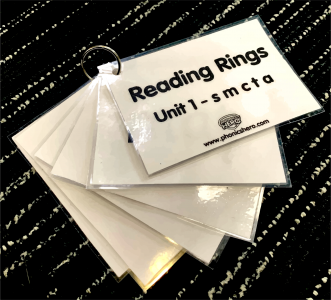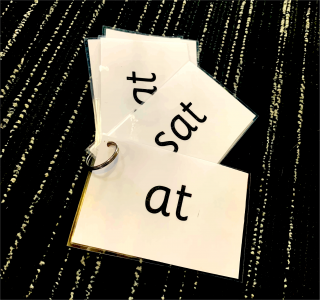Getting to the point where children can move from blending single words to tackling a whole home reader can prove challenging. Our school came up with an easy and incredibly effective way for children to practice decoding at home before they’re ready for the challenge of home readers.
My primary school follows a systematic, synthetic phonics approach in the early years. We teach 20 minutes of explicit phonics each day and use decodable books as our home readers. The books, like the one pictured below, are sent home with children to reinforce and apply their learning.
 Kit and Dog, a decodable home reader.
Kit and Dog, a decodable home reader.The books are decodable and simple, but we came up against one big problem: they were just too hard for a 4 or 5-year-old who was new to blending. I asked myself: “If a child knows the sounds in the book and has started blending, what makes reading these books so hard?”
To explain this, I looked at working memory and cognitive overload. According to Cognitive Load Theory, our working memory is a:
cognitive system with a limited capacity that is responsible for temporarily holding information available for processing.”
Miyake, 1997
And when the capacity of the working memory is exceeded, cognitive overload occurs.
Once this happens, we are unlikely to be able to transfer the new information into our long-term memory. In essence, we learn very little.”
Sweller, 1988
When a child reads the word ‘shop’, having decoded ‘sh’ and ‘o’, their working memory holds onto these two pieces of information whilst they decode ‘p’. Then, their working memory blends all three pieces of information together to form ‘shop’. Sweller found that the average 5-6 year old can hold and manipulate two distinct items of information in their working memory – it’s already quite an ask to get a child to blend a three-sound word together.
Now let’s think about the quantity of information, on top of decoding, we are expecting a child to process in one of ‘simple’ home readers:
It’s a huge burden on a child’s working memory to cope with this quantity of information. No wonder they can experience cognitive overload when reading decodable books! Watch one of my 4-year-old students, who was new to blending, tackle this decodable home reader. At 25 seconds she tackles the word ‘sun’ – it’s the perfect example of a burdened working memory. She can’t easily and automatically remember the sound for the ‘u’ and ‘n’ so becomes overburdened with decoding, and all comprehension of what she has read goes out the window! She even physically shows the effort involved by collapsing onto the bed.
A Reading Ring is essentially a set of decodable words on a keyring – nothing fancy, but so effective!


Our idea was borne from a need to support those children who have started learning their letter sounds but weren’t ready for the demands on their working memory presented by decodable home readers. It might be that they are still learning the full set of letter sounds, or are not yet quick and automatic in blending.
We implemented the Reading Rings using words from Phase 2, splitting them into 3 sets (we follow the ‘Letters and Sounds’ order of sounds in Phonics Hero). The Reading Rings are divided into groups according to the order of sounds you use. They are:
| |
||
B) ck, e, u, r |
||
| |
B) ff, ll, ss |
Along with a helpful set of instructions for parents.
Each child receives a set dependent on our assessment data (you can use Phonics Hero’s free assessment tools in a Teacher Account), which includes their knowledge of sounds and ability to blend. Some sets have subsets; we labelled ours a, b, c, d etc. It’s unimportant if a child has set 3a or set 3d as they will still use words from the same group of sounds. This ensures children do not experience cognitive overload with the quantity of words and only practise a handful – not a bucket load!
We then sent the Reading Rings home, along with a laminated instruction sheet to show parents how these can be used to support their child’s reading development. Children whose assessments placed them beyond Reading Rings started on the home readers immediately.
Of course, our end-goal is for children to move on to reading a decodable home reader. However, there’s no fixed timescale. Children are usually ready once they are consistent at blending and can more or less blend any Phase 2 word. I’ve moved some children onto books after about four to five sets of the Reading Rings. Others are still on their first level or have only changed once or twice.
Although a little time-consuming to create and organise, the Reading Rings made a fantastic improvement in children’s enthusiasm and ability to blend. We have regularly heard many children ‘read’ throughout the week, and much more than if they had they been plodding painfully through a phonics book. The words themselves bring about conversations on vocabulary as well as consolidating children’s knowledge of the letter sounds.
“The Reading Rings were a great first step, getting my daughter (and me!) used to blending sounds and reading words. They were easy to have around and look at when we had a spare moment and my daughter found them fun to use.”
Lizzie Tomlinson, parent of Eleanor, aged 4
I do have one regret about the Reading Rings: I wish we had thought to use these with previous year groups!